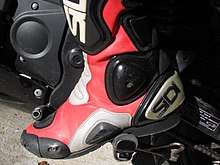Sequential manual transmission
A sequential manual transmission is a type of manual transmission used mostly for motorcycles and racing cars.[1] It produces faster shift times than traditional synchronized manual transmissions and restricts the driver to selecting either the next or previous gear.
| Automotive transmissions |
|---|
| Manual |
| Automatic / Semi-automatic |

Design


A sequential manual transmission allows the driver to select either the next gear (e.g. shifting from first gear to second gear) or the previous gear (e.g., shifting from third gear to second gear), operated either via electronic paddle-shifters mounted behind the steering wheel or with a sequential shifter. This restriction avoids accidentally selecting the wrong gear; however, it also prevents the driver from deliberately "skipping" gears.[2] The use of dog-clutches (rather than synchromesh) results in faster shift speeds than a manual transmission.[3]
On a sequential manual transmission, the shift lever operates a ratchet mechanism that converts the fore and aft motion of the shift lever into rotation of a selector drum (sometimes called a barrel) which has three or four tracks machined around its circumference.[4] Selector forks are guided by the tracks, either directly or via selector rods. The tracks deviate around the circumference and as the drum rotates, the selector forks are moved to select the required gear.[5]
A sequential manual transmission is not to be confused with a "sequential" shifting function sometimes fitted to hydraulic automatic transmission, marketed with terms such as "Tiptronic" or "SportShift". This function allows the driver to select the previous or next gear through the use of buttons or a lever (usually near the gear shifter or steering wheel); however, the mechanicals of the transmission remains unrelated to a sequential manual transmission.
Usage
Most modern motorcycles use a sequential manual transmission. Controlling the gear shifter with the rider's foot allows their hands to remain on the handlebars.[6] However, most motor scooters do not use a sequential manual transmission, instead using either a hydraulic automatic transmission or a continuously variable transmission.
Many racing cars also use a sequential transmission now (either via a sequential shifter lever or with paddle-shifters), rather than the old H-pattern stick shift, beginning with paddle-shifted Formula One cars during the 1990s. Due to the high rate of wear and abrupt shifting action, sequential manual transmissions are rarely used in passenger cars, albeit with some exceptions.
References
- Cameron, Kevin (1998). Sportbike Performance Handbook. Motorbooks. p. 82. ISBN 9780760302293.
Motorcycle transmissions and the latest auto-racing gearboxes are of the sequential type
- "Gearbox technologies". www.drivingfast.net. 27 October 2016. Retrieved 2 January 2020.
- "How Sequential Gearboxes Work". www.howstuffworks.com. 4 April 2003. Retrieved 2 January 2020.
- "How Sequential Gearboxes Work". www.howstuffworks.com. 4 April 2003. Retrieved 2 January 2020.
- "BMW M3 SMG - Short Take Road Test - Auto Reviews". Car and Driver. Archived from the original on 2009-04-08. Retrieved 2011-08-29.
- Cameron, Kevin (2009), Top Dead Center 2, Motorbooks, p. 58, ISBN 9780760336083
